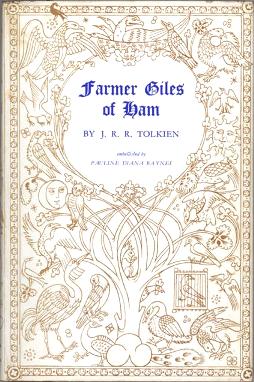
Farmer Giles of Ham is a comic medieval fable written by J. R. R. Tolkien in 1937 and published in 1949. The story describes the encounters between Farmer Giles and a wily dragon named Chrysophylax, and how Giles manages to use these to rise from humble beginnings to rival the king of the land. It is cheerfully anachronistic and light-hearted, set in Britain in an imaginary period of the Dark Ages. It features mythical creatures, medieval knights, and primitive firearms.
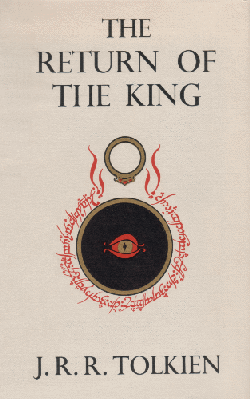
The Return of the King is the third and final volume of J. R. R. Tolkien's The Lord of the Rings, following The Fellowship of the Ring and The Two Towers. It was published in 1955. The story begins in the kingdom of Gondor, which is soon to be attacked by the Dark Lord Sauron.

The Adventures of Tom Bombadil is a 1962 collection of poetry by J. R. R. Tolkien. The book contains 16 poems, two of which feature Tom Bombadil, a character encountered by Frodo Baggins in The Lord of the Rings. The rest of the poems are an assortment of bestiary verse and fairy tale rhyme. Three of the poems appear in The Lord of the Rings as well. The book is part of Tolkien's Middle-earth legendarium.
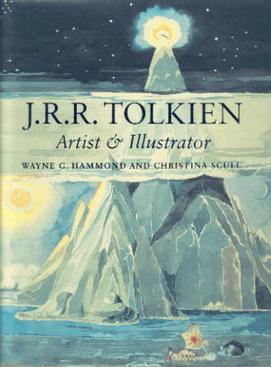
J. R. R. Tolkien: Artist and Illustrator is a collection of paintings and drawings by J. R. R. Tolkien for his stories, published posthumously in 1995. The book was edited by Wayne G. Hammond and Christina Scull. It won the 1996 Mythopoeic Scholarship Award for Inklings Studies. The nature and importance of Tolkien's artwork is discussed.

The Mythopoeic Awards for literature and literary studies are given annually for outstanding works in the fields of myth, fantasy, and the scholarly study of these areas. Established by the Mythopoeic Society in 1971, the Mythopoeic Fantasy Award is given for "fiction in the spirit of the Inklings", and the Scholarship Award for non-fiction work. The award is a statuette of a seated lion, with a plaque on the base. It has drawn resemblance to, and is often called, the "Aslan".
The following outline is provided as an overview of and topical guide to the real-world history and notable fictional elements of J. R. R. Tolkien's fantasy universe. It covers materials created by Tolkien; the works on his unpublished manuscripts, by his son Christopher Tolkien; and films, games and other media created by other people.
The works of J. R. R. Tolkien have generated a body of research covering many aspects of his fantasy writings. These encompass The Lord of the Rings and The Silmarillion, along with his legendarium that remained unpublished until after his death, and his constructed languages, especially the Elvish languages Quenya and Sindarin. Scholars from different disciplines have examined the linguistic and literary origins of Middle-earth, and have explored many aspects of his writings from Christianity to feminism and race.
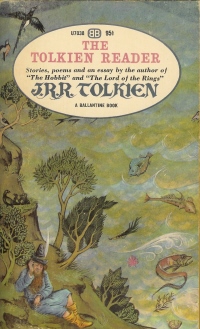
The Tolkien Reader is an anthology of works by J. R. R. Tolkien. It includes a variety of short stories, poems, a play and some non-fiction. It compiles material previously published as three separate shorter books, together with one additional piece and introductory material. It was published in 1966 by Ballantine Books in the USA.
Wayne Gordon Hammond is an American scholar known for his research and writings on the works of J. R. R. Tolkien.
Christina Scull is a British researcher and writer best known for her books about the works of J. R. R. Tolkien, in collaboration with her husband Wayne G. Hammond who is also a Tolkien scholar. They have jointly won Mythopoeic Scholarship Awards for Inklings Studies five times.

The Homecoming of Beorhtnoth Beorhthelm's Son is a work by J. R. R. Tolkien originally published in 1953 in volume 6 of the scholarly journal Essays and Studies by Members of the English Association, and later republished in 1966 in The Tolkien Reader; it is also included in the most recent edition of Tree and Leaf. It is a work of historical fiction, inspired by the Old English poem The Battle of Maldon. It is written in the form of an alliterative poem, but is also a play, being mainly a dialogue between two characters in the aftermath of the Battle of Maldon. The work was accompanied by two essays, also by Tolkien, one before and one after the main work. The work, as published, was thus presented as:

The Lord of the Rings: A Reader's Companion (2005) is a nonfiction book by the scholars Wayne G. Hammond and Christina Scull. It is an annotated reference to J. R. R. Tolkien's heroic romance, The Lord of the Rings.
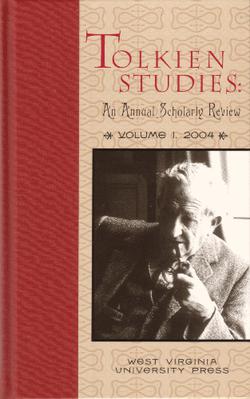
Tolkien Studies: An Annual Scholarly Review is an academic journal founded in 2004 publishing papers on the works of J. R. R. Tolkien. The journal's founding editors are Douglas A. Anderson, Michael D. C. Drout, and Verlyn Flieger, and the current editors are Michael D. C. Drout, Verlyn Flieger, and David Bratman. It states that it is the first scholarly journal published by an academic press in the area of Tolkien research.
The Viking Club was a club for philologists and historians specializing in Germanic and Scandinavian studies.

The Letters of J. R. R. Tolkien is a selection of the philologist and fantasy author J. R. R. Tolkien's letters. It was published in 1981, edited by Tolkien's biographer Humphrey Carpenter, who was assisted by Christopher Tolkien. The selection, from a large mass of materials, contains 354 letters. These were written between October 1914, when Tolkien was an undergraduate at Oxford, and 29 August 1973, four days before his death. The letters are of interest both for what they show of Tolkien's life and for his interpretations of his Middle-earth writings.
"Fastitocalon" is a medieval-style poem by J. R. R. Tolkien about a gigantic sea turtle. The setting is explicitly Middle-earth. The poem is included in The Adventures of Tom Bombadil.

A Companion to J. R. R. Tolkien is a 2014 book edited by Stuart D. Lee and published by Wiley-Blackwell. It is a part of the Blackwell Companions to Literature series, which have been described as prestigious reference works, and features authors well-known in the field of Tolkien studies.

Tolkien's artwork was a key element of his creativity from the time when he began to write fiction. The philologist and author J. R. R. Tolkien prepared a wide variety of materials to support his fiction, including illustrations for his Middle-earth fantasy books, facsimile artefacts, more or less "picturesque" maps, calligraphy, and sketches and paintings from life. Some of his artworks combined several of these elements.
Michael Foster, known as Mike Foster, was an emeritus professor of English and a Tolkien scholar. In 1978 he pioneered the teaching of Tolkien studies at university level.

J. R. R. Tolkien included many elements in his Middle-earth writings, especially The Lord of the Rings, other than narrative text. These include artwork, calligraphy, chronologies, family trees, heraldry, languages, maps, poetry, proverbs, scripts, glossaries, prologues, and annotations. Scholars have stated that the use of these elements places Tolkien in the tradition of English antiquarianism.













